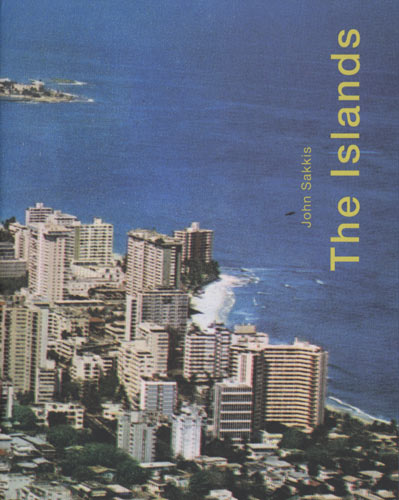The Islands
Throughout John Sakkis’s The Islands, a polyvocal weave of declarative refrains sound out in dizzying display. Across the book’s five sections appear poems, often in set series, presenting a hybrid mix of memoir, lyric, historical investigation, and daily documents full of dispatch concerning discursive news the poet’s ear has picked up on. We see in section three “Tangrams The New Collective,” the speaker’s concern throughout remains with “The salt of human projects,” in the face of which, Sakkis declares: “I go in. I am in bits.” What’s left for the poems are scattered fragments of events, both imagined and other, from out of which both structure and content prove to be derived. Throughout John Sakkis’s The Islands, a polyvocal weave of declarative refrains sound out in dizzying display. Across the book’s five sections appear poems, often in set series, presenting a hybrid mix of memoir, lyric, historical investigation, and daily documents full of dispatch concerning discursive news the poet’s ear has picked up on. We see in section three “Tangrams The New Collective,” the speaker’s concern throughout remains with “The salt of human projects,” in the face of which, Sakkis declares: “I go in. I am in bits.” What’s left for the poems are scattered fragments of events, both imagined and other, from out of which both structure and content prove to be derived.
In the opening section “A Large Population of Antiques,” a halting sense of possible setting, or series of settings, are introduced corresponding with the image on the book’s cover—Pablo Guardiola’s I wish to communicate with you, K/Kilo, an aerial shot of what looks to be some island resort high rises displayed with a faux 1970s graininess. This calls to mind television shows like Hawaii Five-O or Magnum P.I. The familial nod given by the book’s dedication to Sakkis’s mom, Carol Ann, and lines such as “the beach is an even playing field for / insects, cousins and boats,” along with:
the entire hotel is only accessible by
boat or on foot, a small bay brings
law and order to the beaches
place readers within the comfortable realm of recalling family vacations and other childhood reverie, or perhaps dreams of the ideal vacation. Though, these soon shift and expand as we move further along through the book. Quite often there’s danger of feeling lost, overwhelmed by “that rotating stable // of landscapes” where place names and locations become ever myriad and timeless: “from Piraeus to Oakland / thence by Sandbar.” Sakkis’s poems span such vast geographical space and time, refusing rational descriptive limits.
The Islands invites readers into its scenery of an ever evolving state of consciousness where the only viable perspective is one of groundlessness. It is only from there that Sakkis has discovered: “I’m able to be sure / in this role of oxygen.” From such lofty heights of abstract exchanges these poems take shape, giving onto a series of fragmentary glimpses, and providing a series of framed sets in perspective after perspective for confronting the residue of events only hinted at.
Yet, however nebulous the surface presentation, these poems operate at a depth below first appearances. Sakkis has set his aim upon weightier substance. What might be called his “characters” often go unnamed as they are phantoms of a shared individuality ever greater than its many parts:
which slept inside
the rock
which the mind
is made up
which exenterates
the islands
and then and then
so it became
an immediate rime
Exenterate means: “To disembowel; eviscerate.” And by use of the word here, Sakkis gives an insight into these “islands” of which his poems are both comprised of and addressed to. For it is only by way of participation by both the reader and the writer that the full circularity of intention found within these poems reaches any level of comprehension.





